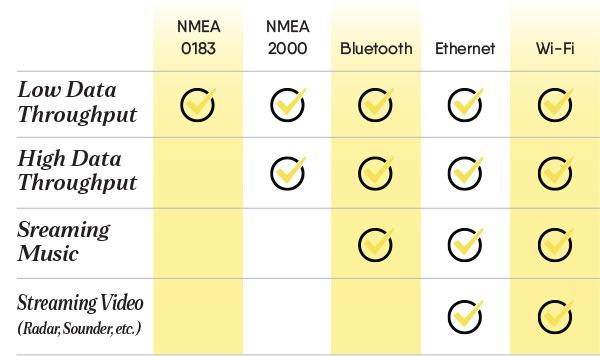In a recent Hotwire article, we looked at the difference between NMEA 0183 and NMEA 2000 electronic communication protocols. This month we are going to go a step further and compare NMEA to Ethernet, WiFi, and Bluetooth. Most new onboard devices are compatible with all four, but what are the advantages of each technology on your boat?
NMEA
Let’s start with a quick review. The National Marine Electronics Association (NMEA) was formed by a group of electronics dealers to grow their relationship with the electronics manufacturers. As technology started to take off in the marine industry, the association realized there must be some way for equipment from different manufacturers to share information. In 1980, the first NMEA 0180 standard was created and then updated in 1983 to NMEA 0183.
The NMEA 0183 protocol defined how electronic signals were transmitted along a serial data bus. Each bus could have many listening devices but only one talking device. This is the most prevalent network we see on boats built before the early 2000s. However, most boaters never really realized the full benefits of interconnecting many electronic devices on board because of the difficulty of implementing NMEA 0183.
In most NMEA 0183 installations, it was used to connect a VHF radio to a chartplotter for GPS coordinates or used to integrate an autopilot with a chartplotter to see heading waypoints and routing information.
For the average boater, NMEA 0183 was not plug and play nor straightforward to install. With the increased need to share data across more and more devices, the newer NMEA 2000 was developed to allow any device to talk to another device. NMEA 2000 is closer to plug and play ready, scalable, and much easier to install. Unlike NMEA 0183, which uses a serial connection, NMEA 2000 uses a Controller Area Network (CAN bus), which allows all parts of your boat to communicate with one another. NMEA 2000, also known as N2K, replaces all of the NMEA 0183 wiring and interconnections with one single cable backbone and allows for multiple, simultaneous talkers and listeners.
The data that can be shared over NMEA 2000 is nearly endless. If there is an N2K sensor, it can be shared. Everything from wind speed, barometric pressure, GPS position, AIS targets, fuel flow sensors, smoke detectors, engine data, bilge levels, you name it. Manufacturers have even created converter devices that allow for NMEA 0183 to NMEA 2000 and vice versa to share info across both NMEA networks.
 Ethernet
Ethernet
While NMEA takes care of lower speed sensor networks, Ethernet is still required for high-speed data like radar, sonar, sharing charts, and video cameras. These RJ45 type connectors that you find in your home are not rugged enough to be exposed on the back of a chartplotter. Manufacturers, like Raymarine, have improved the RJ45 connector with a waterproof, vibration tolerant, twist pin connector specifically designed for the marine environment. A NMEA standard for the transfer of data using the 802.3 Ethernet protocol is also being developed and will be called OneNet.
To complicate matters even more, each manufacturer uses proprietary technology, so there is no sharing of radar or sounder imaging between manufactures. For example, a boater cannot mix a Furuno Radar with a Garmin chartplotter. Setting up an Ethernet connection on your boat allows your radar, sounders, and chartplotters (aka multi-function displays) to be interconnected.
Wi-Fi
All of the major marine equipment manufacturers have added a Wi-Fi component either directly through the display or via a Wi-Fi black box. This was another game changer as it allowed boaters to not only view but also control any chartplotter on the boat with a smart device. This upgrade instantly adds a mobile second helm or allows crew members away from the helm to follow along on the trip. Wi-Fi also allows for instant updates on weather or even software.
Bluetooth
Bluetooth connectivity provides a convenient means of interconnecting some marine electronic devices. The most obvious is a Bluetooth speaker, headset, or stereo deck that allows you to not only listen to music but to change songs and control the volume.
However, that is just the beginning. Victron has a battery monitor with a Bluetooth wireless feature that allows boaters to configure and view the state of the batteries from anywhere on the boat. Victron even has a solar controller that will enable you to wirelessly access via Bluetooth for information about your solar panel output.
Getting away from it all certainly has changed over the past ten years. Being connected to friends and family, the office, or checking in on your house through video, Wi-Fi can add peace of mind to our time on the water. Not only that, but if you have to leave your boat unattended, you can rest easy knowing that you can monitor pretty much everything from battery levels to GPS location.
The most significant advantage is still safety. An interconnected boat ensures that critical data is not “stuck” in one place only and is shared and available throughout the boat to the whole crew.